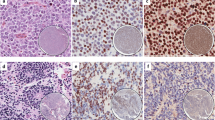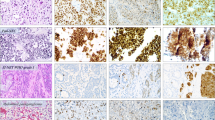Abstract
Neuroendocrine (NE) breast carcinoma is defined by morphological features similar to those of NE tumors of other organs and NE marker expression in at least 50 % of neoplastic cells. However, a NE morphology may be observed even in breast carcinomas lacking NE markers. Human achaete-scute homolog-1 (hASH-1) is a transcription factor that plays a key role in the regulation of mammalian neural and NE cell development and has been identified in several human NE tumors. The aim of this study was to investigate hASH-1 expression in human breast cancers. hASH-1 expression was evaluated in 482 consecutive non-NE invasive breast carcinomas, in a series of 84 breast cancers with >50 % NE marker expression (high NE differentiation) and 21 carcinomas with NE histology but negative or focally (<50 %) positive for NE markers (low NE differentiation). hASH-1 protein was evaluated by a specific monoclonal antibody using immunohistochemistry and gene expression by real-time polymerase chain reaction. None of the non-NE invasive breast carcinomas expressed hASH-1 at any levels. hASH-1 was expressed in tumor cell nuclei of 63 and 38 % of cases with high and low NE differentiation, respectively. Strong correlation with protein and gene expression levels was observed (p < 0.0001). hASH-1 expression was correlated to a low mitotic count (p = 0.02) and a low Ki67 proliferative index (p = 0.0062). hASH-1 expression occurs in breast cancers with NE differentiation regardless of the extent of the NE cell population, and it is restricted to a subset of tumor cells having a low proliferative potential.





Similar content being viewed by others
References
Cubilla AL, Woodruff JM (1977) Primary carcinoid tumor of the breast. A report of eight patients. Am J Surg Pathol 1:283–292
Ellis P, Schnitt SJ, Sastre-Garau X (2003) Invasive breast carcinoma. In: Tavassoli FA, Devilee P (eds) Tumours of the breast and female genital organs. Pathology and genetics. World Health Organization Classification of Tumours. IARC Press, Lyon
Righi L, Sapino A, Marchio C, Papotti M, Bussolati G (2010) Neuroendocrine differentiation in breast cancer: established facts and unresolved problems. Semin Diagn Pathol 27(1):69–76
Wei B, Ding T, Xing Y, Wei W, Tian Z, Tang F, Abraham S, Nayeemuddin K, Hunt K, Wu Y (2010) Invasive neuroendocrine carcinoma of the breast: a distinctive subtype of aggressive mammary carcinoma. Cancer 116(19):4463–4473. doi:10.1002/cncr.25352
Tavassoli F, Eusebi V (2009) AFIP atlas of tumor pathology. Armed Forces Institute of Pathology, Washington DC
Lopez-Bonet E, Alonso-Ruano M, Barraza G, Vazquez-Martin A, Bernado L, Menendez JA (2008) Solid neuroendocrine breast carcinomas: incidence, clinico-pathological features and immunohistochemical profiling. Oncol Rep 20(6):1369–1374
Miremadi A, Pinder SE, Lee AH, Bell JA, Paish EC, Wencyk P, Elston CW, Nicholson RI, Blamey RW, Robertson JF, Ellis IO (2002) Neuroendocrine differentiation and prognosis in breast adenocarcinoma. Histopathology 40(3):215–222
Sapino A, Bussolati G (2002) Is detection of endocrine cells in breast adenocarcinoma of diagnostic and clinical significance? Histopathology 40(3):211–214
Sapino A, Righi L, Cassoni P, Papotti M, Pietribiasi F, Bussolati G (2000) Expression of the neuroendocrine phenotype in carcinomas of the breast. Semin Diagn Pathol 17(2):127–137
Moriya T, Kanomata N, Kozuka Y, Fukumoto M, Iwachido N, Hata S, Takahashi Y, Miura H, Ishida K, Watanabe M (2009) Usefulness of immunohistochemistry for differential diagnosis between benign and malignant breast lesions. Breast Cancer 16(3):173–178
Capella C, Usellini L, Papotti M, Macri L, Finzi G, Eusebi V, Bussolati G (1990) Ultrastructural features of neuroendocrine differentiated carcinomas of the breast. Ultrastruct Pathol 14(4):321–334
Massari ME, Murre C (2000) Helix-loop-helix proteins: regulators of transcription in eucaryotic organisms. Mol Cell Biol 20(2):429–440
Casarosa S, Fode C, Guillemot F (1999) Mash1 regulates neurogenesis in the ventral telencephalon. Development 126(3):525–534
Guillemot F, Joyner AL (1993) Dynamic expression of the murine Achaete-Scute homologue Mash-1 in the developing nervous system. Mech Dev 42(3):171–185
Huber K, Bruhl B, Guillemot F, Olson EN, Ernsberger U, Unsicker K (2002) Development of chromaffin cells depends on MASH1 function. Development 129(20):4729–4738
Tomita K, Nakanishi S, Guillemot F, Kageyama R (1996) Mash1 promotes neuronal differentiation in the retina. Genes Cells 1(8):765–774
Hirsch MR, Tiveron MC, Guillemot F, Brunet JF, Goridis C (1998) Control of noradrenergic differentiation and Phox2a expression by MASH1 in the central and peripheral nervous system. Development 125(4):599–608
Borges M, Linnoila RI, van de Velde HJ, Chen H, Nelkin BD, Mabry M, Baylin SB, Ball DW (1997) An achaete-scute homologue essential for neuroendocrine differentiation in the lung. Nature 386(6627):852–855
Osada H, Tomida S, Yatabe Y, Tatematsu Y, Takeuchi T, Murakami H, Kondo Y, Sekido Y, Takahashi T (2008) Roles of achaete-scute homologue 1 in DKK1 and E-cadherin repression and neuroendocrine differentiation in lung cancer. Cancer Res 68(6):1647–1655
Rostomily RC, Bermingham-McDonogh O, Berger MS, Tapscott SJ, Reh TA, Olson JM (1997) Expression of neurogenic basic helix-loop-helix genes in primitive neuroectodermal tumors. Cancer Res 57(16):3526–3531
Ball DW, Azzoli CG, Baylin SB, Chi D, Dou S, Donis-Keller H, Cumaraswamy A, Borges M, Nelkin BD (1993) Identification of a human achaete-scute homolog highly expressed in neuroendocrine tumors. Proc Natl Acad Sci USA 90(12):5648–5652
Shida T, Furuya M, Nikaido T, Kishimoto T, Koda K, Oda K, Nakatani Y, Miyazaki M, Ishikura H (2005) Aberrant expression of human achaete-scute homologue gene 1 in the gastrointestinal neuroendocrine carcinomas. Clin Cancer Res 11(2 Pt 1):450–458
Miki M, Ball DW, Linnoila RI (2011) Insights into the achaete-scute homolog-1 gene (hASH1) in normal and neoplastic human lung. Lung cancer (Amsterdam, Netherlands). doi:10.1016/j.lungcan.2011.05.019
Rapa I, Ceppi P, Bollito E, Rosas R, Cappia S, Bacillo E, Porpiglia F, Berruti A, Papotti M, Volante M (2008) Human ASH1 expression in prostate cancer with neuroendocrine differentiation. Mod Pathol 21(6):700–707
Vias M, Massie CE, East P, Scott H, Warren A, Zhou Z, Nikitin AY, Neal DE, Mills IG (2008) Pro-neural transcription factors as cancer markers. BMC Med Genomics 1:17. doi:10.1186/1755-8794-1-17
Hartman J, Lam EW, Gustafsson JA, Strom A (2009) Hes-6, an inhibitor of Hes-1, is regulated by 17beta-estradiol and promotes breast cancer cell proliferation. Breast Cancer Res 11(6):R79. doi:10.1186/bcr2446
Capella C, Eusebi V, Mann B, Azzopardi JG (1980) Endocrine differentiation in mucoid carcinoma of the breast. Histopathology 4(6):613–630
Ceppi P, Volante M, Saviozzi S, Rapa I, Novello S, Cambieri A, Lo Iacono M, Cappia S, Papotti M, Scagliotti GV (2006) Squamous cell carcinoma of the lung compared with other histotypes shows higher messenger RNA and protein levels for thymidylate synthase. Cancer 107(7):1589–1596
Heid CA, Stevens J, Livak KJ, Williams PM (1996) Real time quantitative PCR. Genome Res 6(10):986–994
Righi L, Papotti MG, Ceppi P, Bille A, Bacillo E, Molinaro L, Ruffini E, Scagliotti GV, Selvaggi G (2010) Thymidylate synthase but not excision repair cross-complementation group 1 tumor expression predicts outcome in patients with malignant pleural mesothelioma treated with pemetrexed-based chemotherapy. J Clin Oncol 28(9):1534–1539. doi:10.1200/JCO.2009.25.9275
Guillemot F, Lo LC, Johnson JE, Auerbach A, Anderson DJ, Joyner AL (1993) Mammalian achaete-scute homolog 1 is required for the early development of olfactory and autonomic neurons. Cell 75(3):463–476
Linnoila RI, Zhao B, DeMayo JL, Nelkin BD, Baylin SB, DeMayo FJ, Ball DW (2000) Constitutive achaete-scute homologue-1 promotes airway dysplasia and lung neuroendocrine tumors in transgenic mice. Cancer Res 60(15):4005–4009
Iyoda A, Hiroshima K, Toyozaki T, Haga Y, Fujisawa T, Ohwada H (2001) Clinical characterization of pulmonary large cell neuroendocrine carcinoma and large cell carcinoma with neuroendocrine morphology. Cancer 91(11):1992–2000
Sapino A, Righi L, Cassoni P, Papotti M, Gugliotta P, Bussolati G (2001) Expression of apocrine differentiation markers in neuroendocrine breast carcinomas of aged women. Mod Pathol 14(8):768–776
Ball DW (2004) Achaete-scute homolog-1 and Notch in lung neuroendocrine development and cancer. Cancer Lett 204(2):159–169
Axelson H (2004) The Notch signaling cascade in neuroblastoma: role of the basic helix-loop-helix proteins HASH-1 and HES-1. Cancer Lett 204(2):171–178. doi:10.1016/S0304-3835(03)00453-1
Elston CW, Ellis IO (1991) Pathological prognostic factors in breast cancer. I. The value of histological grade in breast cancer: experience from a large study with long-term follow-up. Histopathology 19(5):403–410
Conflict of interest
The authors do not have any conflicts of interest to declare with regard to the current study.
Author information
Authors and Affiliations
Corresponding author
Rights and permissions
About this article
Cite this article
Righi, L., Rapa, I., Votta, A. et al. Human achaete-scute homolog-1 expression in neuroendocrine breast carcinoma. Virchows Arch 460, 415–421 (2012). https://doi.org/10.1007/s00428-012-1223-1
Received:
Revised:
Accepted:
Published:
Issue Date:
DOI: https://doi.org/10.1007/s00428-012-1223-1




